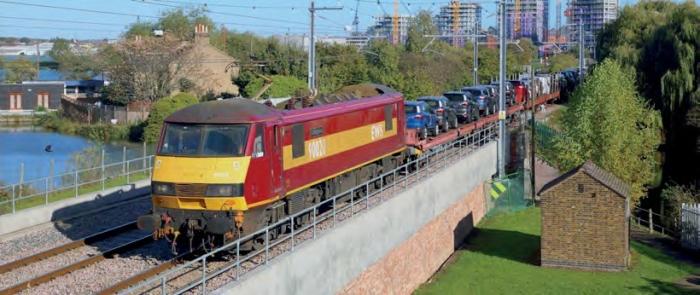BUT DECARBONISATION REPORT HIGHLIGHTS CHALLENGES FOR FREIGHT VEHICLES

THE REMOVAL of diesel-only passenger trains from the network by 2040 is achievable, but there is no ‘silver bullet’ and different solutions will be required. That is the conclusion of the interim report from the Rail Decarbonisation Taskforce and RSSB. While the report concludes that a solution is possible for passenger trains, it says the removal of diesel-only freight and maintenance trains presents ‘a unique challenge’ and calls for further research and development in this area.
The taskforce was set up following then Rail Minister Jo Johnson’s challenge to industry to remove all diesel-only trains from the network by 2040. It is led by former Angel Trains CEO Malcolm Brown, alongside representatives of the Rail Freight Group, Rail Delivery Group, Network Rail, the Railway Industry Association and RSSB.
The report suggests the best solution for passenger trains is ‘a mix of new traction options and efficiency improvements now under various stages of development and implementation, in areas where electrification is not, and is never likely to be, available’. It notes electrification is currently the most carbon efficient power source ‘where it is cost-effective and appropriate’. But it says other power sources such as bi-mode, hydrogen and battery technology are developing fast, and calls for ‘a concerted industry and government effort to support research and development’ of these to enable targeted deployment.
For high-speed inter-city services and freight, which demand very high energy and power delivery requirements, high acceleration and long periods between refuelling, the taskforce suggests there are no suitable alternatives to electric and diesel traction available within the timescales to 2040. It recommends putting in place ‘transitional arrangements’ that may life-extend existing vehicles while the industry, and for innovation programmes to take place in key areas. This could include life-extending existing diesel vehicles or introducing diesel vehicles that can be easily upgraded with low carbon traction systems. The Flirt bi-mode units ordered by Greater Anglia from Stadler are cited as an example, with the ability to remove their diesel power pack and convert them to straight EMUs in future. The use of more efficient and cleaner diesel is also proposed as an option.
Making maximum use of the existing electrified network is suggested to be at the core of the decarbonisation strategy. Where the electrified network is not complete, on-board battery solutions are called for to bridge gaps, with charging at the end of a journey if required; if the distance is too great for batteries to be used then bi-mode technology is called for. Hydrogen, bi-mode and hybrid trains are encouraged where extension of the electrified network is not feasible or will not be the most effective solution.
Regarding freight, the report suggests removing diesel ‘remains an aspiration in the absence of any plan to electrify key freight routes’ and that replacement traction options do not yet exist to do this in a commercially viable manner, although it notes bi-mode and battery technology ‘could deliver significant improvements’. It calls for research into more sustainable fuels, and notes that options such as hydrogen will require an additional fuel tank to be fitted to a train, reducing the number of wagons that could be hauled and therefore the train’s payload. RSSB has commissioned a further technical study to look at options for freight in greater detail
